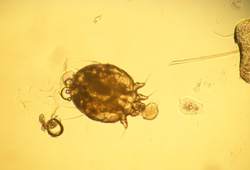Last reviewed: 16 Mar 2025
Last updated: 28 Mar 2023
Summary
Definition
History and exam
Key diagnostic factors
- infants, children, and older adults
- history of overcrowding
- history of itching in family members or close contacts over the same period
- generalised and intense pruritus, typically worse at night
- burrows
- papules, vesicles, excoriations
- positive ink burrow test
Other diagnostic factors
- papules on face, neck, palms, and soles in children
- immunosuppression
- bullae
- thick, crusted lesions occurring on elbows, knees, hands, and feet with dystrophic nails
- nodules
Risk factors
- overcrowded living conditions/poverty
- living in close quarters with others who are infected
- age under 15 or over 65 years
- sexual contact with new or multiple partners
- immunosuppression
- poor hygiene
- contact with an infected animal
- contact with contaminated clothing, towels, and bedding
- winter season
Diagnostic investigations
Treatment algorithm
Contributors
Authors
Ryan Harris, MD
Dermatologist
Treasure Valley Dermatology and Skin Cancer Center
Boise
ID
Disclosures
RH declares that he has no competing interests.
Acknowledgements
Dr Ryan Harris would like to gratefully acknowledge Dr Pooja Khera and Dr Laura Korb Ferris, previous contributors to this topic.
Disclosures
PK and LKF declare that they have no competing interests.
Peer reviewers
David Cassarino, MD, PhD
Assistant Professor
Department of Pathology and Laboratory Medicine
University of California
Los Angeles
CA
Disclosures
DC declares that he has no competing interests.
Roderick J. Hay, DM, FRCP, FRCPath, FMedSci
Chairman
International Foundation of Dermatology
London
UK
Disclosures
RJH declares that he has no competing interests.
Use of this content is subject to our disclaimer
